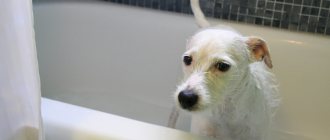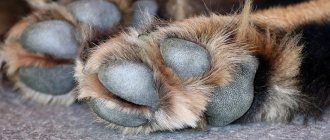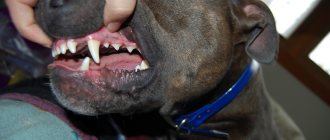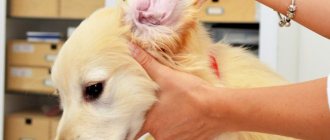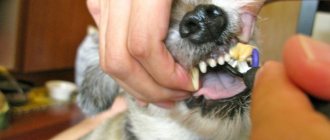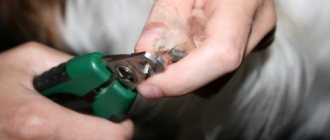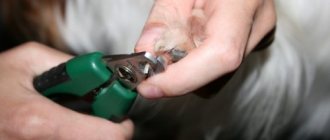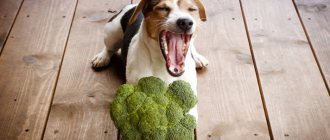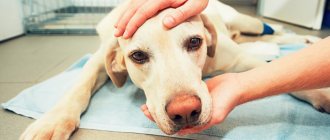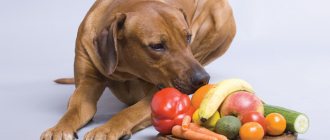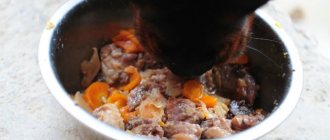Not every owner knows how to brush a dog’s teeth correctly, and most owners even believe that this procedure is unnecessary. In fact, caring for your pet’s oral cavity is necessary and should become a regular ritual. Yes, a dog does not need to brush its teeth like a person - several times a day, but two to three times a week you need to do this to avoid various dental diseases.
Today we will tell you what actions the owner can carry out at home, look at toothpastes and devices for cleaning dog teeth, and also talk about the ultrasonic cleaning procedure, which is carried out in a veterinary hospital.
How to brush your dog's teeth?
Caring for your dog's teeth at home
You won't be able to let an adult dog know why you should brush your teeth. The pet will not like attempts to interact with the mouth, the dog may behave aggressively. Therefore, it is worth accustoming your pet to this action from childhood, when baby teeth are just being replaced.
To start brushing your teeth, you need to purchase a special paste and brush for dogs from a pet store, and also stock up on treats. The procedure should be started when the dog is tired and does not have the strength to show aggression.
Now you need to consider the technique of brushing dogs’ teeth at home:
- The place must have access to water (bathroom, shower);
- The dog should be calm, let it sniff the toothpaste and brush;
- The dog’s lip is in a raised state, the teeth are exposed, move your fingers along them;
- If there is no aggression, then slowly begin brushing your teeth, from the gums to the end of the teeth, cleaning the enamel. If desired, in addition to the outside, you can also clean the inside, although there the dog itself gets rid of plaque. While moving the brush over the teeth, sometimes touch it with your fingers so that the pet gets used to it faster;
- Food or foreign objects stuck in the teeth can be removed with tweezers;
- The procedure should last a couple of minutes so as not to mentally harm the dog;
- Don’t forget to talk to and praise your dog, and never yell at it. After cleaning, give your pet a treat or toy, but only if it behaves well. If the dog is aggressive, do not reward him.
Pay attention to your teeth daily or, if possible, several times a week.
If hygiene products are purchased specifically for dogs, then there is nothing to be afraid of, everything is safe and will not harm the pet. No matter how difficult it may be, the dog must be accustomed to this procedure; this is the path to good health.
If this doesn’t work out, contact your veterinarian, he will help you find an approach to your dog, recommend pastes, special toys, brushes, and cleaning techniques.
In addition, he will examine the pet for the presence of stones on the teeth, yellowness, odor from the mouth and gum health. If necessary, he will advise on your pet’s illnesses, tell you about cleaning your dog’s teeth from tartar and its nuances, and give advice and recommendations.
Rules and selection criteria
When choosing a dental hygiene item for your dog, there are several important aspects to consider:
- breed;
- pet size;
- individual characteristics.
For large breeds, medium-hard human toothbrushes can be used. Small breeds require more delicate cleansing, so for such dogs you should purchase a milder product.
It is not safe to use the paste and rinse for humans with pets. In the best case, the dog will simply refuse to brush; in the worst case, the toothpaste or mouthwash will get into the digestive organs. As a result, the dog may experience indigestion.
After the expiration date of the paste and in case of damage to the toothbrush (delamination of the bristles, breakage of the handle), you should purchase new dental supplies, otherwise you may injure your gums.
Tools for cleaning your dog's teeth
Toothbrushes. There are many brushes, different in shape, size and hardness.
- It is worth focusing on the age, height and characteristics of the dog.
- In addition, there are brushes that fit on your finger or with a handle, depending on your taste.
Why brush your teeth?
Why should a person brush their teeth? This question seems equally illogical when you think about it. Cleaning your dog's mouth is necessary to keep your pet healthy. If you do not pay attention to his teeth, sooner or later plaque will appear on them, and then tartar, which is why they will begin to decay and fall out. And this, naturally, will have a bad effect on the health of your pet - he only has one set of teeth for his entire life, and you need to treat him with the utmost care.
Additionally, dental problems are one of the most common causes of bad dog breath. It is unlikely that you will enjoy playing with a pet that smells disgusting.
Toothpastes for dogs
Some people, without first reading information about cleaning products for dogs, buy toothpastes for people. This cannot be done! The composition of the paste for people and dogs is different and can be harmful.
The dog cleaner has a less pungent odor, taste and does not foam.
- One of the folk remedies is hydrogen peroxide. It is necessary to take 1% or dilute 3% with water (1:3).
- In addition, activated carbon and chlorhexidine are used.
- After turning the tablet into powder and dipping the bandage, they begin cleaning.
Naturally, it is best to use special pastes, because folk remedies can ruin the enamel.
What do you need for home cleaning?
How to brush your dog's teeth? Will I need anything special for this procedure or can I get by with human paste and a regular brush?
Human paste is a categorical no. It contains a huge amount of chemicals, and during cleaning the dog will swallow a lot of paste and foam. Human paste will cause vomiting at best, and serious stomach problems at worst. Moreover, dog toothpastes often have a meaty taste and smell, so the process of brushing teeth will also be quite pleasant for your pet.
It’s also better not to skimp on the brush. Pet stores sell excellent toothbrushes for dogs that not only remove plaque, but also perfectly massage the gums, making the brushing process more enjoyable.
Gel for the gums will also be useful - a massage with it will bring more benefits to the dog, but, in principle, you can do without it.
Getting rid of tartar on teeth
If the owner does not take care of the pet’s teeth and leaves everything to chance, there is a high probability of the formation of stone on the tooth, which injures the gums and provokes the appearance of certain diseases.
You can get rid of it by mechanically or ultrasonic cleaning your dog’s teeth.
- In the first option, the dog is under anesthesia, and the doctor independently removes the plaque.
- Cleaning a dog's teeth without anesthesia is carried out using ultrasound, but only once every two years.
- The teeth are cleaned completely, on both sides, the procedure takes up to one and a half hours.
The price of cleaning a dog’s teeth with ultrasound is around 2,500 rubles in the clinic. Having found a suitable option and signed up for the procedure, you should read reviews about brushing your dog’s teeth with this doctor.
Useful tips
- Proper nutrition has a good effect on crowns, making them stronger and more resistant to rotting. Give the dog high-quality food, muscles, large cartilages. If your pet's crowns are loose, it is better not to give dogs a hard bone to clean their teeth.
- To clean, use a brush specially designed for pets.
- Never use human toothpaste, only buy product intended for dogs.
- Before the procedure, give your pet a sample of the toothpaste to try. The tasty smell will make him more accommodating.
- Encourage your dog with games, petting, and favorite activities to make him more accommodating and improve the cleaning process.
- If you are unable to remove plaque, purchase a dog treat or dental cleaning ball.
- When your pet quickly chews the teething stick, buy her a larger toy.
- If the animal has bad teeth, do not give hard toys.
Prevention of diseases
To prevent your pet from developing caries, pulpitis, gingivitis, ulcers of the mucous membranes and other diseases, you should carefully monitor its oral cavity. This is why they brush their teeth, carry out special procedures and are sensitive to the topic of caring for pets.
While the dog is a puppy, it is necessary to accustom it to constant examinations and procedures.
This will help maintain healthy teeth in adulthood and avoid many diseases, which also include stomach and intestinal diseases.
Features of storing toothbrushes
The shelf life of a brush for dogs of small and large breeds is about 4–5 months. As a rule, by this time the owner himself notices changes in the condition of the bristles, and in some cases, wear of the handle. In addition, those brushes that were used to clean the animal’s teeth during the period of illness must be replaced. A large number of pathogenic microbes accumulate on the pile, so such brushes should be thrown away.
After the cleaning procedure, the brush should be rinsed with warm water and placed in a dry place. It is strictly forbidden to store dog hygiene items with human ones. It is also not recommended to store brushes in cases. There they remain wet for a long time, which creates ideal conditions for the reproduction and activity of bacteria.
Dental hygiene procedures are considered an important aspect of caring for your furry pet. Therefore, they cannot be neglected even if the animal resists. To make these procedures as comfortable as possible for the dog, you need to be patient and kind words.
Recommended Posts
At what age and how do dogs begin to change teeth?
Review of 8 super premium dog foods
38 best dog breeds for apartments according to reviews from breeders and owners
Review of cat food or how to choose quality food
Top 7 popular hypoallergenic cat breeds
Review of 7 popular premium cat foods
Photo instructions for brushing a dog's teeth
What if the dog is not given?
You do everything according to the instructions, but your dog still growls and gets angry, not allowing you to brush his teeth? Something about the cleaning procedure confuses her, and your job is to figure out what it is.
First, you can try a different brush and a different toothpaste - these are the easiest ways to solve the problem, the problem may be how to brush your dog’s teeth. If you see that your four-legged dog is nervous, under no circumstances should you raise your voice at him. On the contrary, you should pet your pet, calm him down, telling him that nothing terrible awaits him. Your intonation will most likely help your pet relax at least a little. During the cleaning process, do not hesitate to praise your dog and pamper him with treats. Don’t be afraid that your dog will swallow the paste along with the treats – it is completely harmless to the animal’s body.
Some suggest restraining the four-legged dog during a procedure that is unpleasant for him, but this option is unlikely to work - the dog will perceive it as violence against itself, and this does not contribute to the formation of a trusting relationship between you.
In the most advanced cases, you will have to seek the help of a veterinarian.
Features of cleaning in the clinic
Veterinarians' help is needed in cases where the owner does not pay due attention to caring for the pet's oral cavity. A specialist will help you notice or prevent the development of serious diseases in time.
Indications for an urgent visit to the clinic are:
- bleeding gums;
- caries;
- unpleasant odor;
- tooth loss.
In these cases, the doctor usually performs ultrasonic cleaning. The procedure takes from 20 to 90 minutes. It all depends on the situation. It is performed under general anesthesia. Before visiting the clinic, the dog should not eat for 8-12 hours.
Ultrasonic cleaning involves removing plaque and tartar under and above the gums, washing the periodontal canals, whitening the enamel and treating the oral cavity with antibacterial solutions.
After removing the stone, the surface of the teeth needs additional polishing, since irregularities remain on it. It is carried out using special brushes of different hardnesses.
